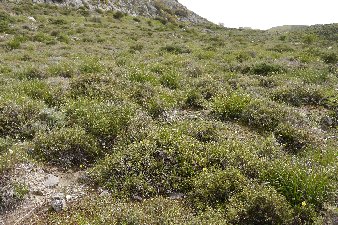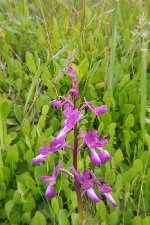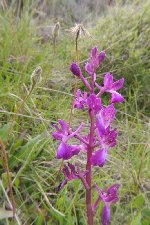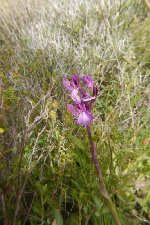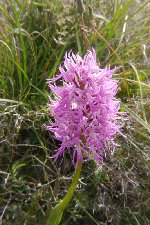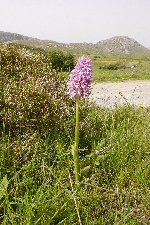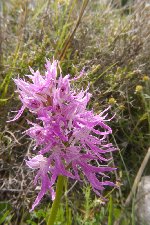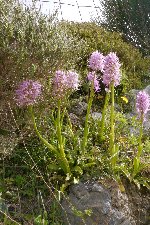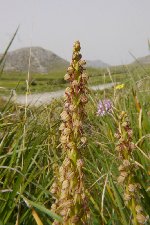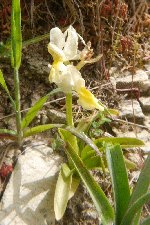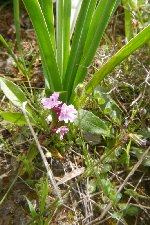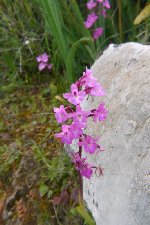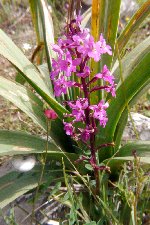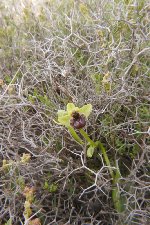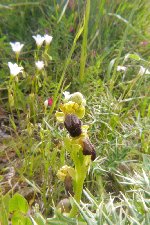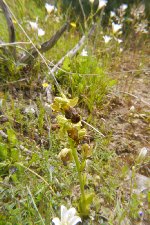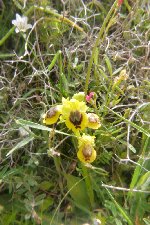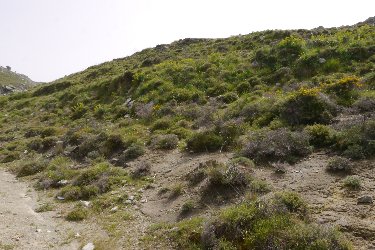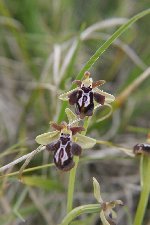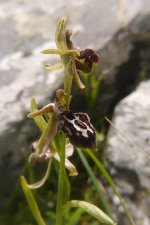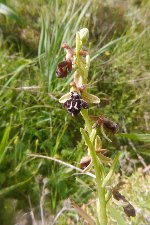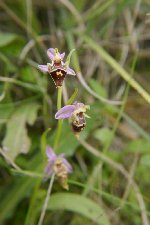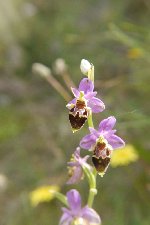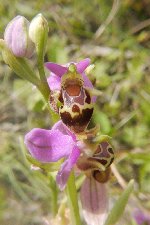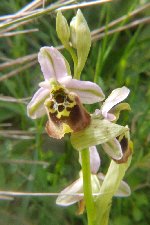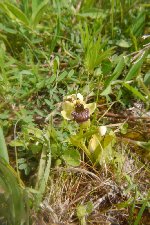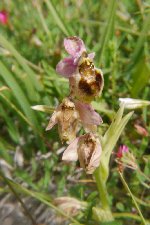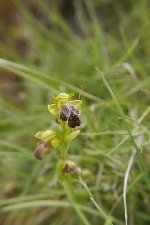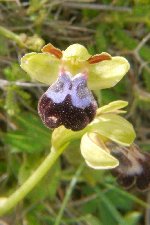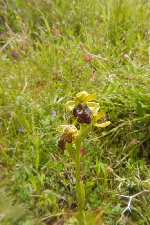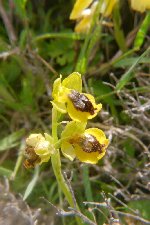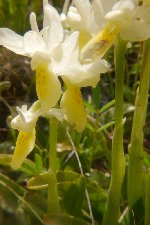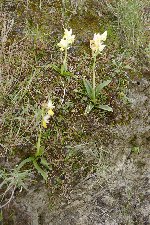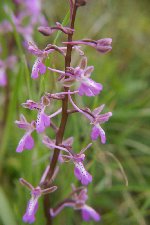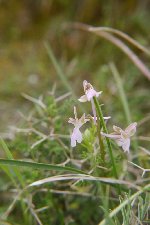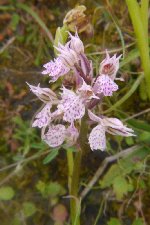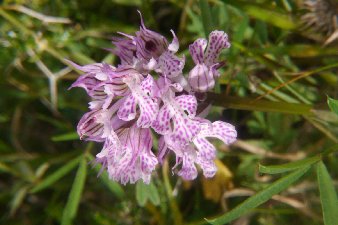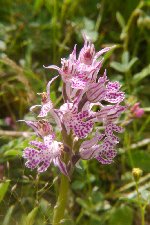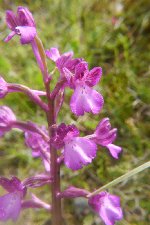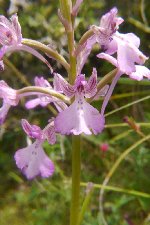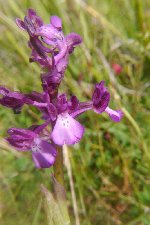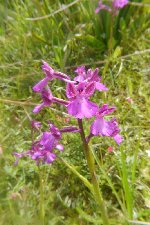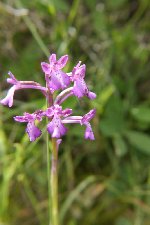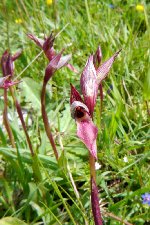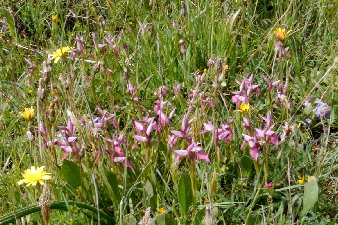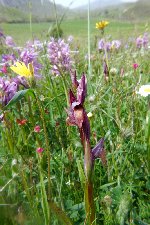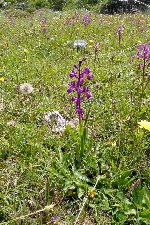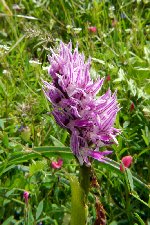|
|
|||||||||||
|
|
|||||||||||
 |
|
The Gravel Track site one (35.21308 24.57270) Towards the end of the first day of orchid searching were were left with two sites close by each other, and not far from the Spili hillock. We chose to explore the one that bordered the road, rather than explore down a gravel track. The rented car was not insured for off road travel and we had no idea how far we would have had to go in unrelenting afternoon sun. Today, though, we have returned and set off down the gravel track. Immediately we spot Anacamptis laxiflora at the road side, where moisture is seeping off the hills above. Actually it is not far to our first stop. The guides we have been using actually refers to sites on the hill behind a chapel, but this is fenced off, so we go another hundred yards or so to an open bit of phrygana. This is has a great orchid flora and is probably no worse than and just as productive as the hillside. Others of the genus was A. boryi. The Orchis genus was represented by O. anthropoporum, O. italica (actually looking quite good), O. pauciflora and O. quadripunctata. The last occurs in a range of pinks, but the plant on the third photo seems a little unusual. A very vibrant pink, and a large robust plant. It suggests the possibility of being a hybrid, but with what. This species often hybridises with O. sitiaca or O. anatolica. Neither are resent at this site but O. anatolica does grow at the next and nearby site.
Surprisingly, Ophrys does not feature well with just Op. bombilifera, Op. creberrima and O. phrygana seen. I wondered whether the Op. creberrima might be O. cinerophilia (which has been recorded nearby), but the plants seen had no real yellow border to the lip, and did have a well defined groove at the lip base.
The Gravel Track site two (35.21248 24.57340) This area is just a few hundred yards further along the track, and a similar terrain. However, it is west facing rather than south facing. This might be more significant in the UK, but despite this there does seem to be some difference in the orchid flora over the two sites. It may not be sun position as the factor, but perhaps water drainage - or just chance of what we stumbled across, as we couldn't cover every square foot of both sites. What did strike me was that these two areas, close enough together to be considered as a whole had as many, if not more orchids than the famous hillock. Hard to believe, looking at the site photo, that an hour's search or so revealed some 18 orchid taxons. Unlike the last site the Ophrys genus is well represented. Both Op. cretica ssp. cretica and ssp. ariadne seem to be present. The more familiar Op. heldreichii , Op. episcopalis and Op. bombilifera can also be found, and also a very much past its best Op. tenthedrinifra. Of the fusca tribe are Op. creberimma and cinerifolia. The latter i.d. is tentative and based on the yellow border to the lip. Op. phrygana too.
Orchis species also differ from the neighbouring site. O. anthropoporum and O. pauciflora are common to the two sites, but also here is O. anatolica , with their long up-curving spurs (looking quite pale and ghostly), and a mystery Orchis which seems similar but is very pale and very small. Surprisingly, no O. italica were found here.
I found photographing the Neotinea tridentata a bit tricky. Get one bit in focus and the rest was blurred. Luckily I took enough to find a couple worth posting here. Some had very prominent and intensely spotted lip and sepals; I have seen those called var angelica online, but can find no reference to that elsewhere. The remainder of the orchids here are a very few S. lingua and what appear to be Anacamptis boryi. However these are mostly paler and/or redder than other examples seen in Crete. And one, below and on it's own, could actually be a hybrid with A. laxiflora. The Gravel Track site three (35.21400, 24.56900) A quite different habitat for this final site. It is actually a meadow on the right hand side just after you start down the gravel track from the road. We avoided it on the way down, as it was already swarming with a party photographing the orchids. Not a great diversity, but stunning in numbers - probably because it gets the rain draining off the hills across the road. By now, the fifth day, I am coming down with orchid fatigue. While the hire car is due back the next day, I just do not think that without heading off somewhere in a quite different area of Crete there is time to find anything me to see. It is a blazing hot day, and a cup of iced coffee seems the best of ideas. We have ended on a high with over 20 different orchids seen in a very close area.
|
|
|
||||||||||||||
